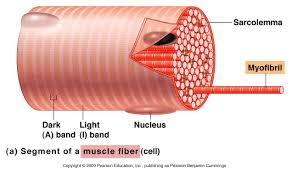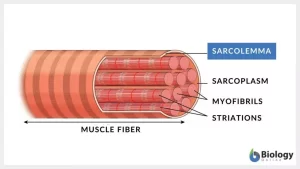

The sarcolemma is also called the myolemma.
The sarcolemma is the cell membrane surrounding a skeletal muscle fiber or a cardiomyocyte.
The sarcolemma consists of a lipid bilayer and a thin outer coat of polysaccharide material that contacts the basement membrane.
The sarcolemma basement membrane contains numerous collagen fibrils and specialized proteins such as laminin that provide a scaffold to which the muscle fiber can adhere.
Via transmembrane proteins in the plasma membrane, the actin skeleton inside the cell is connected to the basement membrane and the cell’s exterior.
At the end of the muscle fiber, the surface layer of the sarcolemma fuses with a tendon fiber, and the tendon fibers, in turn, collect into bundles to form the muscle tendons that adhere to bones.
The sarcolemma has the same function in muscle cells as the plasma membrane does in other eukaryote cells.
The Sarcolemma acts as a barrier between the extracellular and intracellular compartments, defining the individual muscle fiber from its surroundings.
The lipid nature of its membrane allows it to separate the fluids of the intra- and extracellular compartments.
Its membrane is selectively permeable to water through aquaporin channels.
Membrane proteins may create ion gradients with the consumption of ATP, to drive transport of other substances through the membrane or generate electrical impulses such as action potentials.
The sarcolemma invaginates into the sarcoplasm of the muscle cell, forming membranous tubules radially and longitudinally within the fiber called T-tubules or transverse tubules.
On either side of the transverse tubules are terminal cisternal enlargements of the sarcoplasmic reticulum.
